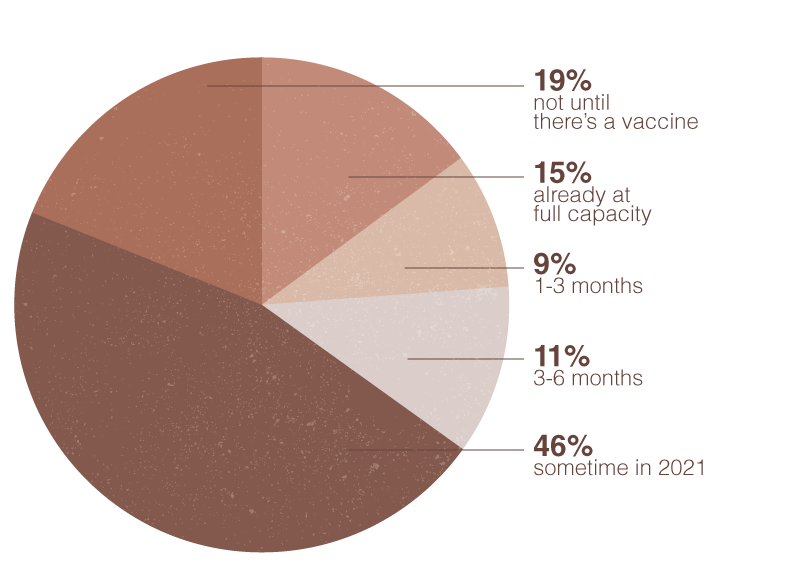Organizations have made accommodations to meet COVID-19 state and local mandates under ever-tightening economic conditions—and must balance these changes with an eye on their budgets and the health of their business and people.
We have seen a spike in interest in work-from-home corporate programs, screens, and reconfiguration services. We consider much of the activity in recent months as exploratory work that helps our clients better understand their options, and envision a timeline that returns them to full occupancy. What we know now is that some organizations are recalculating what full occupancy means, what percentage of their workforce can continue to work from home, and what the ramifications of such a long-term change look like.
Adding into that calculation is an effective vaccine. The impact of the vaccine, according to Dr. Soumya Swaminathan, chief science officer at the World Health Organization, and Bill Gates, might restore “pre-pandemic health levels,” no sooner than 2022, or two years from the present. Matt Perez, Forbes
Our survey responders reinforced our anecdotal evidence that a majority are either still working from home or working in an office that is partially occupied. A whopping 46% of respondents do not expect to reach full occupancy until 2021.
when do you expect your workplace to reach full capacity?

Almost 20% of respondents have not considered when to return, basing their comfort level on the availability of a vaccine.
What are the main concerns that are keeping people away from the workplace?
Exposure, of course, tops the list. The upside here is that our respondents seem aware of the health risks involved in shared spaces, as well as the challenges businesses face in creating safer environments. Among preferences for steps businesses could take to improve comfort with office spaces, access to sanitization supplies, dedicated workspaces, and face masks top the list.
Limiting occupancy was more polarizing, then the next top options were nightly cleaning and furniture reconfiguration.
Childcare and the state of the education system continues to stymie working parents, teachers and childcare professionals as they navigate shifting schedules and shifting local guidelines. This concern didn’t top the list in our survey, but the destabilization of childcare, in particular, could have widespread ramifications for the US economy.
“Without access to affordable and convenient childcare, many parents—mostly mothers—will find it increasingly untenable, financially and logistically, to work outside the home. It’s an eventuality that could cripple women’s advancement in the workplace, exacerbate inequality, and put a drag on the U.S. economic recovery.”
Time, September 8, 2020
The Battle to Repopulate Offices
Organizations are caught between encouraging people to return and adjusting protocols to mitigate the risks that in-person contact brings. And workers are stuck between feeling socially isolated working from home, and lacking the confidence in their employers that enough has been done to keep them safe in their office space.
A recent Wired article, Bosses are doing weird things to get people back in the office, cites tactics being used by global brands such as Bloomberg, Price Waterhouse Cooper, and Citigroup to coax people back. Perks like free beverages or food are nice, but they do not address worker safety concerns as much as support for commuting alternatives and a desk reservation system.

top concerns for working in an office (in order)
exposure at the office
spreading COVID-19 to coworkers
decreased flexibility to WFH
decreased productivity
organizing childcare
leaving family members at home who need assistance
not returning for health reasons
exposure during commute to work
The larger challenge seems to be that “there’s a huge variety of motivations for people staying home, and these transcend safety and finances” and therefore organizations may end up providing “individualized” solutions.
Employers and employees seek the same outcome, to restore the magic of in-person interactions that feed social and emotional health, and organizational and economic prosperity. The journey toward that goal is likely to be a long and experimental period, filled with give and take from both sides.
Read the complete elemeant Fall issue
Photo credit: The Nordic | design by Studio BV | photo by Corey Gaffer


